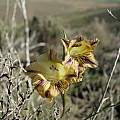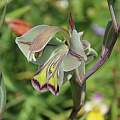Most Gladiolus sport a few lines and spots on their flowers, but there are some so heavily patterned that the base color becomes obscured.
Gladiolus ceresianus L.Bolus grows on stony slopes and flats in clay soil from southern Namaqualand to the western Karoo and in the Roggeveld and Bokkeveld Plateau. It is a small plant, up to 10 cm tall with linear leaves with four longitudinal grooves and one to four flowers in a inclined spike that are brown to purple with dark veining. Flowers are pleasantly scented. This species flowers from August to October in the wild. Flowers are similar to Gladiolus uysiae, but that species has flat leaves. It is also very similar to Gladiolus virescens, but has dark, hard scales around the corms. Photo 1 from Cameron McMaster taken on the Matjiesfontein Sutherland road in the Roggeveld, photo 2 from Alan Horstmann, and photo 3 from Rod Saunders. The last two photos from the book Plants of the Klein Karoo courtesy of Jan and Anne Lise Schutte-Vlok.
Gladiolus dalenii Van Geel is a widespread and common species found not only in Southern Africa, but also in other parts of tropical Africa. It has been known by a number of names over the years; there have been 27 synonyms for the tropical Africa and Madagascar forms and 14 more for the southern African forms. The main synonyms for the southern Africa collections have been Gladiolus natalensis and Gladiolus psittacinus. This species blooms at different times of the year depending on the location, but there are probably flowers every month of the year somewhere in its native habitats. Flowers are either red to orange with yellow markings on the lower half of the three lower tepals or yellow to greenish with red to brown streaks on the upper tepals. Although it favors moist habitats and is often found in grassland, it can also be found in dry habitats with only a short wet season. The ones I grew in Northern California lived for a number of years in the garden, dormant during our wet winters, appearing late spring and surviving through the dry summer and blooming in the fall. The flowering stalks were very tall with a number of flowers. Photos 1-2 of those plants were taken by Mary Sue Ittner. Photo 3 by Cameron McMaster shows plants in cultivation. Photos 4-5 by Mary Hunter and Mary Sue Ittner show the first bloom from seed of a yellow form of ssp. dalenii, once known as Gladiolus primulinus blooming in late summer in Northern California. The last photo by David Pilling shows seed.
The first photo below from Cameron McMaster shows flowering plants in habitat in the Eastern Cape. The second is another habitat shot taken near Balloch in the Eastern Cape, January 2010 by Bob Rutemoeller. Photo Nr. 3 from Rachel Saunders shows an unusual color form and was taken in northern KwaZulu-Natal in January 2015. The last photo shows the beautiful detail on likely the same color form, as the seeds were obtained from Silverhill, flowering the second year from seed for Martin Bohnet.
Gladiolus ecklonii Lehmann (syn. G. marmoratus, G. inclusus) is widespread in the summer rainfall area where it is found in well watered low grassland. It has flowers that are minutely spotted or dotted pink, red or purple on a white background. The lower tepals are yellow to cream. The flowers may be so evenly covered with uniformly pink or dark red spots that they look that color. From a distance the flowers on my plants looks almost brown. The attractive leaves are bright green in a fan with thickened margins. The species is named after C. F. Ecklon, the plant collector who first sent seeds of it to the Hamburg Botanic Garden. The first two photos are of plants blooming September 2004 in California by Mary Sue Ittner.
The first four photos were taken by Cameron McMaster in the Eastern Cape and the last was taken by Rod Saunders.
Gladiolus fourcadei (L.Bolus) Goldblatt & M.P.de Vos, syn. Homoglossum fourcadei (L.Bolus) N.E.Br, syn. Antholyza fourcadei L.Bolus, grows in a variety of soils in the Uniondale district of the Southern Cape. It has small, greenish yellow flowers with reddish veins and spots. This species is endangered, and reportedly now grows in only a single location threatened by overgrazing. The first photo was taken by Rod Saunders and the next three by Mary Sue Ittner.
Gladiolus guthriei F.Bolus is a winter-growing species that occurs on rocky sandstone outcrops in the Western Cape. It incorporates plants formerly known as Gladiolus odoratus L.Bolus. It blooms in fall to early winter; April to June in its native range. Plants that will bloom send up a flowering stalk with very short leaf stubs on it. Plants not blooming in that year produce a long leathery leaf. The flowers generally have a pale yellow or straw base color, liberally decorated with mauve or dark magenta streaks and freckles. The result looks fairly dull from a distance, but the flowers reward close examination. They have a sweet scent. First four photos taken in Napier and Villiersdorp in the Overberg by Cameron McMaster. The fourth and fifth photos are of the Gladiolus odoratus form, blooming in December in California by Michael Mace.
Gladiolus hyalinus Jacq. is a wide spread species in the winter-rainfall region where it is found from Namaqualand to the southwestern Cape and in a couple of places in the southern Cape and the Eastern Cape. In the Cape Flora region it is found in transitional fynbos and in Namaqualand on granite derived sand or clay. It flowers from winter into spring depending on the elevation. Flowers are light to reddish brown on a pale cream background. There are dark spots and streaks on the throat. The first five photos taken by Mary Sue Ittner who grew her plants from seed. Photos 4-5 were taken in a later year of flowers that look very different from the flowers of the one that bloomed in the past. The last photo was taken by Andrew Harvie on the R27, near Nieuwoudtville.
Gladiolus inflexus Goldblatt & J.C.Manning is endemic to only a few places in the Southwestern Cape where it grows in sandstone derived gravel. Growing from 20 to 35 cm, it has 1 to 3 purple flowers formed on a wiry bent stem. The sweetly scented flowers have a strongly arched dorsal tepal and a large lower median tepal that is greater than the lower laterals. The bases of the tepals and the throat are cream with the lower tepals speckled to blotched purple. Flowering time is mid to late July, sometimes into August. The first photo was taken by Rachel Saunders. The next three were taken by Alan Horstmann.
The next three photos from iNaturalist were taken by Douglas Euston-Brown in July near Worcester and shared under a CC BY-SA license.
Gladiolus maculatus Sweet extends across the southern coast and immediate interior of the winter rainfall area to the Eastern Cape where it is often found growing in heavy soils in renosterveld. Flowers are dull yellow to lilac and speckled with brown or purplish spots. They are long-tubed and fragrant during the day and the evening. The first three pictures were taken by Cameron McMaster near Napier and Bredasdorp in the Overberg.
The first two pictures below are of garden flowers taken by Mary Sue Ittner December 2007 and January 2009. The next two were taken by Alan Horstmann and the last by Dirk Wallace.
Gladiolus orchidiflorus Andrews is found on clay and sandstone soils from Namibia to Cape Flats and also to Free State and flowers in the spring. It has linear to sword-shaped leaves that are thickened in the midline. Flowers are in a 5 to 12 flowered spike, windowed in profile, greenish to purple with dark purple markings on the lower tepals, and are very fragrant. Photos 1-2 are habitat shots taken in Namaqualand by Bob Rutemoeller and Mary Sue Ittner September 2006. Photos 3-4 were taken near Carolusberg, Namaqualand by Cameron McMaster September 2011.
The photos below were taken by Alan Horstmann.
Gladiolus recurvus Linnaeus occurs in shale derived soils from Ceres to Bredasdorp and flowers from June to October depending on the elevation. The fragrant flowers are pale gray to cream, yellowish or pinkish with purple lines and dots on the lower tepals and sometimes spotted or lined in the midline on the upper tepals as well. The first two photos were taken by Cameron McMaster in the Overberg. The other photos by Dirk Wallace show variation in the markings on flowers.
Gladiolus rufomarginatus G.J.Lewis is a summer-growing species with a narrow distribution in the Lydenburg area of Mpumalanga where it grows in grassland in open or shade on stony shale ground and sometimes in crevices in bare shale outcrops. It has long and slender leaf blades with margins and midrib strongly thickened and raised. Flowers are cream to pale straw and densely speckled with small, dark red spots. Bracts are pale and dry at anthesis and slightly transparent flushed with pink and with rusty brown margins. Photo taken by Rachel Saunders. In habitat it flowers March to April, sometimes in May.
Gladiolus sericeovillosus (Hook) is a medium sized summer flowering Gladiolus related to Gladiolus oppositiflorus with pale cream spotted flowers on a distichous spike from Transvaal grasslands. It comes in two subspecies. Photo from Rod Saunders.
G. sericeovillosus subsp. calvatus (Baker) Goldblatt is characterized by leaves which exceed the flower spike. This species may be found in trade as Gladiolus elliotii, likely because it was described by Lewis under this name, while the accepted Gladiolus elliotii (Baker) is a different species. Pictures by Martin Bohnet show a plant with exactly this misnamed history. He grows it in a container in southern Germany, even though some sources attest it hardiness to USDA Zone 7. The yellow throat markings are optional according to some descriptions.
G. sericeovillosus subsp. sericeovillosus has shorter leaves and fine hair on the bracts and stem. In some specimen, the spots on the flowers may be missing.
Gladiolus uysiae L.Bolus ex G.J.Lewis is brownish purple with dark veining and fragrant. It flowers late winter to early spring and can be found on clay slopes in renosterveld. Photos 1-4 were taken in habitat near Middelpos in the Roggeveld by Mary Sue Ittner, Bob Rutemoeller and Cameron McMaster.
The first three photos were taken by Alan Horstmann in 2023 near Middelpos. The fourth photo was taken by Cameron McMaster near Nieuwoudtville September 2011. The last photo taken by Bob Rutemoeller shows one grown by Gordon Summerfield in South Africa flowering September 2003
Gladiolus vinosomaculatus grows in exposed and often dry sites (rocky hilltops and slopes in short grassland) and on rocky outcrops in the summer rainfall areas of southern Africa north of the Vaal River. The tepals are covered with large purple to reddish spots on a pale background. The leaves have long sheaths that form a short pseudostem. This species is closely related to Gladiolus ecklonii. Photo taken by Rod Saunders.
Gladiolus watermeyeri grows on rocky sandstone slopes in the Northwest Cape. It is very fragrant and we could smell the one growing near Nieuwoudtville in the first photo from Mary Sue Ittner before we saw it. Photo 2 was taken by Rod Saunders. Photos 3-4 from Cameron McMaster were also taken near Nieuwoudtville.



















































































